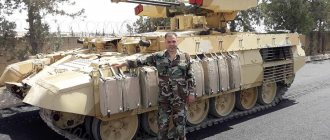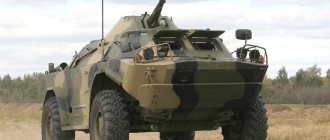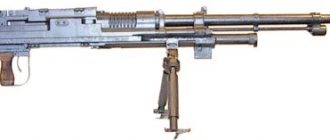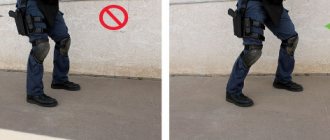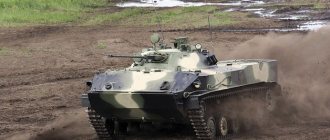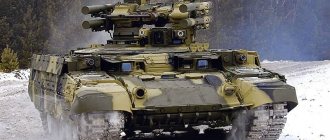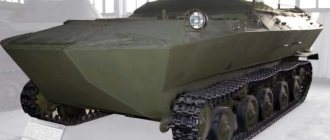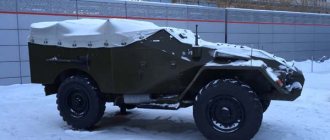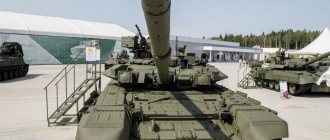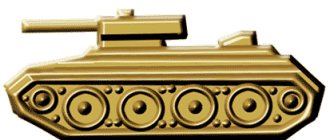In the “cargo” section – is there also military equipment? Yes! The January issue talked about the BTR-82A, and now I was the first among journalists to get acquainted with the newest airborne combat vehicle BMD-4M. All day long at the army training ground I compared the new product with the well-deserved BMD-2, drove these vehicles, took part in shooting... And, paraphrasing the motto of the paratroopers “no one but us,” I can say about the “baemdashki”: no one but them can do this!
A command sounds over the radio - and fire flies out of the barrels, and shell casings rain down onto the concrete platform with a ringing sound. “Ta-ta-ta-ta” - the 30-mm BMD-2 cannon hits like a machine gun. It is echoed, only not so often, by a similar cannon of the newest BMD-4M, and then the powerful 100-mm gun of this vehicle also fires, throwing out a thick piglet cartridge case behind the turret.
A short break, and the “baemdashes” go into the field: shooting on the move, overcoming obstacles. When three tracked vehicles, shrouded in a snow whirlwind, synchronously cross the bridge, almost rearing up - this, brothers, is strong!
The BMD-2 crew fires from a 30-mm automatic cannon; behind her is a BMD-4M
Autoreview readers are accustomed to comparative tests of cars. But comparative tests of tracked armored vehicles? Having received an invitation from the military, I did not expect this. I thought a lone car with a crew was waiting for me at the training ground, but I found myself in the thick of things. There are plenty of combat vehicles. People too. Engines are roaring, paratroopers are running around quickly, and here - .
This is “controlled military exploitation”, which our army owes to the current Minister of Defense Sergei Shoigu. If previously years passed from the appearance of new military equipment to its adoption into service (and the results were often unsatisfactory), now new items are immediately sent to the troops, where they are driven “in tail and mane”, identifying weak points and shortcomings. “And the factory workers are surprised: everything worked fine for them,” the military men laugh.
The BMD-4Ms that will be discussed have been in this type of operation since the end of last summer, but before my visit to the paratroopers, I didn’t really know what kind of vehicles they were. No wonder: the first ten copies are being tested.
What kind of BMD are there?
Having seen the new “baemdashka”, I decided to show that I already knew something about it from the Internet.
- This is the Gardener? - I say.
It would be better to remain silent, honestly. It turned out that the name “Gardener”, which was assigned to the new combat vehicles on the Internet, has nothing to do with them, just like “Bakhcha-U”. All this is a designation of turrets with weapons, but neither one nor the other is installed on the new vehicle. Therefore - just BMD-4M. "Fourth generation, modernized." And to be precise - completely redesigned.
1986, BMD-1 in Afghanistan: the short 73 mm cannon is clearly visible
The BMD-1, put into service in 1969, made a real revolution: the paratroopers received a hitherto unprecedented vehicle - light, compact, floating... And most importantly, parachuted.
I remember well our long-ago report about the first parachute landing experience of a KAMAZ: after a hard landing, its front end was dented. And the "bamdashes" must land not just unharmed, but with the crew inside - and immediately enter into battle!
BMD-4M ammunition (from left to right): 30 mm shells, 7.62 mm machine gun ammunition and 100 mm gun shells
Therefore, the suspension was made hydropneumatic, the body was welded from durable but light aluminum armor (they say for the first time in Soviet history), and since 1971, the driver-mechanic and commander parachuted along with the car - in additional seats, like cosmonauts.
Over ten years, more than two thousand BMD-1s were produced - during this time the model underwent a number of upgrades and managed to fight in Afghanistan. There it turned out that the 73-mm Grom cannon was ineffective. It did not have a stabilizer, it did not allow shooting at mountain tops, and the shells did not penetrate Afghan mud walls well.
After firing in the BMD-2 turret - a natural smoke curtain!
Therefore, the gun of the BMD-2, which entered service in 1985, was replaced with another - automatic, 30 mm caliber (it is called a “helicopter gun” because it is also installed on combat helicopters). And the vehicle turned out to be so successful that it is not only still in service, but also remains the main “armor” of the Russian landing force.
But the BMD-3, which appeared at the turn of the nineties, on the contrary, turned out to be unsuccessful: it received a new armored hull, became larger and much heavier... But the weapons did not change! And since production took place during the era of economic collapse, in eight years the Volgograd Tractor Plant assembled only 137 copies.
I took this photo from the BMD-2 turret: the flames on the sides are from the previous shot
Finally, at the beginning of the 2000s, the BMD-4 appeared - essentially the same three-ruble note, only with a turret from the BMP-3. But this car almost suffered the same fate as its predecessor: the plant in Volgograd went bankrupt, introduction into the troops was incredibly delayed...
And the military didn’t just ask, they demanded new equipment. Here is a quote from an interview with the Commander-in-Chief of the Airborne Forces, Vladimir Shamanov, to Rossiyskaya Gazeta in 2012: “The machine is needed like air. Even in the fight against gangs in the North Caucasus, we lacked firepower. What if the enemy is more serious? With one 30-mm cannon and one anti-tank missile on the turret that fires every once in a while, you can’t fight much today!”
“Hood covers” are removed: in the foreground - BMD-2, in the back - BMD-4M
He was echoed by Chief of the General Staff of the Russian Federation Valery Gerasimov (quote from a speech published in 2013 in Nezavisimaya Gazeta): “BMD-2s are outdated both morally and physically. The cars are 20-25 years old, and sometimes more. The wear and tear of the main components and assemblies does not allow the use of combat capabilities. For this reason, during the march to the training ground (we are talking about a sudden check of the combat readiness of the troops - F.L.), two BMD-2 units failed.”
Notes
- A modernized version of the BMD-2M airborne combat vehicle was shown in the Moscow region. Archived on April 14, 2014.
- The Military Balance 2020. - P. 195.
- The Military Balance 2020. - P. 208.
- The Military Balance 2020. - P. 205.
- The Military Balance 2020. - P. 206.
- ↑ 12
Baryatinsky M.B., 2006, p. 15. - The General Staff is sounding the alarm. Army General Valery Gerasimov analyzed combat readiness. (inaccessible link - history
). Independent newspaper. Retrieved February 17, 2013. - ARMORED VEHICLES IN AFGHANISTAN (1979-1989) Archived June 21, 2012.
- Baryatinsky M.B., 2006, p. 16.
- Military equipment in Chechnya (1999-2000). Air Defense Bulletin. Retrieved December 30, 2020.
- Vyacheslav Kochetkov.
Through the war. Russian reporter (August 13, 2008). Retrieved December 31, 2020. - The Military Balance 2020. - P. 491.
Made in Kurgan
And now, finally, before us is the BMD-4M - developed and made not in Volgograd, but in Kurgan. There are only two external differences from the previous BMD-4: the exhaust (not at the stern, but on the right) and the rollers (with a groove, like the BMD-2). But the “filling”...
Since Kurganmashzavod traditionally produces infantry fighting vehicles, the new infantry fighting vehicle is 60% unified with the BMP-3: it has a chassis, a turret with weapons, water cannons, and electrical equipment.
And a “power unit” with an engine - a 500-horsepower multi-fuel UTD-29 from the Barnaultransmash plant. By the way, the BMD-2 has a diesel engine, also from Barnaul, but 240 horsepower. So the power has more than doubled! Whereas the mass is 1.75 times.
In the engine compartment of the BMD-2 there is a 240-horsepower diesel engine 5D20-240
The BMD-4M has a multi-fuel 500-horsepower UTD-29 engine
0 / 0
And the weapons are not even dual, but triple: a 100 mm gun, a 30 mm automatic cannon and a 7.62 mm machine gun. True, the designers had to make a compromise: since the “helicopter” gun did not fit here, it was replaced with an “airplane” gun, which had a slower rate of fire. But the shooting accuracy, on the contrary, has increased: since the 30-mm barrel is rigidly attached to the thick “pipe” of the 100-mm gun, it does not swing when moving. And if previously, to hit a target on the move, it was necessary to use a dozen or two 30 mm shells, now a few shots are enough for this.
And anti-tank guided missiles (ATGMs) are launched directly through a 100-mm barrel, by pressing a button, whereas with the BMD-2 you have to get out of the car to do this.
Next to the compact BMD-2 (on the left), the new BMD-4M looks like a real tank. The difference in armament is clearly visible: while the BMD-2 has one 30-mm cannon, the BMD-4M has a gun of this caliber paired with a 100-mm gun
Finally, now the BMD is landing not only with the driver and commander, but with the entire crew and landing party. This means that after landing, fighters no longer need to look for their vehicles - which often land several kilometers away...
Of course, you have to pay for everything - for example, the features of landing.
If the BMD-2 can “jump” from different aircraft, from the AN-26 to Antey, then for the larger and heavier BMD-4M only the IL-76 is suitable, and it is now being modernized so that not two, but three vehicles can be landed.
And fuel consumption has almost doubled: for the BMD-2 it is equal, judging by the capacity of the tanks and the power reserve, to 56 l/100 km, and for the new car it is 92 l/100 km. But the power reserve itself remained the same - 500 km.
Well, now it’s time to feel like a driver and gunner! For starters, on the well-deserved BMD-2.
Literature
- 916/916K.00.000TO. BMD-2 and BMD-2K. Technical description and operating instructions. - Volgograd Tractor Plant, 2010. - 317 p.
- Karpenko A.V.
Infantry and airborne combat vehicles // Review of domestic armored vehicles (1905-1995). - St. Petersburg: Nevsky Bastion, 1996. - P. 153. - 480 p. — 10,000 copies. - Engines UTD-20 and 5D20. Technical description. - Military Publishing House of the USSR Ministry of Defense, 1972. - 96 p.
- Baryatinsky M.B.
Airborne combat vehicles. — Supplement to the magazine “Modeler-Constructor”. - 2006. - T. Special issue No. 1(9). — 18 s. (unavailable link)
In service
- Russia - more than 1500 BMD-1/BMD-2/BMD-3 as of 2010]
- Uzbekistan - 9 BMD-2 as of 2010]
- Ukraine - 78 BMD-2 as of 2010]
Images
BMD-2
at tactical exercises of the 137th Guards Airborne Order of the Red Star Regiment of the 106th Guards Airborne Division. September 28, 2011, Ryazan region:
- BMD-2 - 137AirborneRegiment22.jpg
- BMD-2 - 137AirborneRegiment26137AirborneRegiment23.jpg
- BMD-2 - 137AirborneRegiment26137AirborneRegiment24.jpg
- BMD-2 - 137AirborneRegiment26.jpg
- BMD-2 - 137AirborneRegiment27.jpg
- BMD-2 - 137AirborneRegiment01.jpg
- BMD-2 - 137AirborneRegiment30.jpg
- BMD-2 - 137AirborneRegiment35.jpg
- BMD-2 - 137AirborneRegiment36.jpg
- BMD-2 - 137AirborneRegiment37.jpg
- BMD-2 - 137AirborneRegiment38.jpg
- BMD-2 - 137AirborneRegiment26137AirborneRegiment25.jpg
| This is a preliminary article about armored vehicles. You can help the project by adding to it. |
| T-44 · T-54 · T-55 · Object 416 ·
| ||||||||||||||||||||||||||||||||||||
| ||||||||||||||||||||||||||||||||||||
| ASU-76 ·
| ||||||||||||||||||||||||||||||||||||
| BM MLRS and OTRK |
| |||||||||||||||||||||||||||||||||||
| ZSU-37-2 "Yenisei" ·
| ||||||||||||||||||||||||||||||||||||
| BM air defense systems and air defense systems |
| |||||||||||||||||||||||||||||||||||
| ||||||||||||||||||||||||||||||||||||
| ||||||||||||||||||||||||||||||||||||
| ||||||||||||||||||||||||||||||||||||
| * - produced only for export; italics Promising, experimental, or samples that did not go into mass production were identified | ||||||||||||||||||||||||||||||||||||
Armored car Dozor-B TTX, Video, Photo, Speed, Armor
The Dozor-B armored fighting vehicle is an all-wheel drive armored fighting vehicle with a 4x4 wheel arrangement. Designed as a multi-purpose protected vehicle for transporting personnel, weapons and military equipment weighing up to 2 tons. The Dozor-B armored personnel carrier can be effectively used to equip special units of the armed forces (quick reaction forces and military police) when they carry out reconnaissance, patrol, and peacekeeping operations and can be used as the main vehicle in combat conditions (including use of weapons of mass destruction).
Read more…
Performance characteristics of the BMPT Terminator
- Layout scheme: classic - Crew, people: 5 - Developer: UVZ - Years of production: since 2001
Weight of BMPT Terminator
— 48 tons
Dimensions of BMPT Terminator
- Hull length, mm: 6960 - Length with gun forward, mm: 7200 - Hull width, mm: 3370, 3800 - Height, mm: 1940, 3440 - Ground clearance, mm: 406
Armor BMPT Terminator
— Type of armor: rolled and cast steel and multi-layer combined, projectile-resistant, with dynamic protection.
Armament BMPT Terminator
— Caliber and brand of gun: 2 × 30-mm 2A42 — Gun type: rifled small-caliber automatic gun — Gun ammunition: 900 rounds — VN angles, degrees: −5…45 — GN angles, degrees: 360 — Firing range, km : manpower - up to 4000 m; lightly armored vehicles - up to 1500 m; air targets - up to 2000 m with subsonic speeds and slant range up to 2500 m - Sights: main gunner's sight - combined with optical and thermal imaging channels, laser-beam control channel - missile and laser rangefinder commander's sight - panoramic with thermal imaging channel and laser rangefinder sights grenade launcher operators - combined day/night "Agat-MP" navigation system GLONASS - Machine guns: 1 × 7.62 PKTM - 2000 rounds - Other weapons: PU KUV "Ataka-T" - 4 UR 9M120-1 (9M120-1F, 9M120 -1F-1) 2 × AG-17D - 600 rounds
Engine BMPT Terminator
— Engine type: V-92S2- Engine power, l. s.: 1000
Speed BMPT Terminator
— Speed on the highway, km/h: 65 - Cruising range on the highway, km: 550
— Specific power, l. s./t: 20.45 - Suspension type: individual torsion bar - Climbability, deg.: 30 - Crossable wall, m: 0.85 - Crossable ditch, m: 2.7±0.1 - Crossable ford, m: 5, 1.8, 1.2
BMPT Terminator-2
BMPT Terminator-2 left front view
At the REA-2013 exhibition there was a presentation of the BMPT-72 (object 183), based on the T-72 tank chassis. Serial production of the BMPT-72 is declared on the website of JSC NPK Uralvagonzavod in the Special Products section under the title “Terminator-2 fire support combat vehicle,” while the BMPT (object 199) is called “Terminator fire support combat vehicle.”
According to the UVZ management, the modified version of the Terminator BMPT, first presented on September 25, 2014, was created taking into account the requirements of the Armed Forces of the Republic of Kazakhstan. The upgraded sample also received the same name “Terminator-2” from the manufacturer. The name of the modernized model is mentioned in a statement dated October 1, 2014 by the Commander-in-Chief of the Ground Forces of the Russian Federation, Colonel General O. L. Salyukov.
BMPT Terminator-2 left view
BMPT Terminator-2 front view
BMPT Terminator-2 right view
BMPT Terminator-2 front right view
